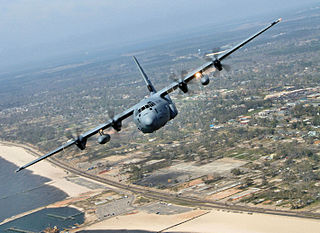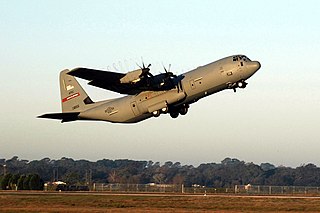
The 452nd Air Mobility Wing is an Air Reserve Component of the United States Air Force. It is assigned to the Fourth Air Force, Air Force Reserve Command, stationed at March Air Reserve Base, California. If mobilized, the Wing is gained by the Air Mobility Command.

The 374th Airlift Wing is a unit of the United States Air Force assigned to Fifth Air Force. It is stationed at Yokota Air Base, Japan. It is part of Pacific Air Forces. The 374th Airlift Wing is the only airlift wing in PACAF and provides airlift support to all Department of Defense agencies in the Pacific theater of operation. It also provides transport for people and equipment throughout the Kantō Plain and the Tokyo metropolitan area.

The 50th Air Refueling Squadron is a unit of the US Air Force, assigned to the 6th Operations Group, 6th Air Refueling Wing at MacDill Air Force Base, Florida. It operates the Boeing KC-135R Stratotanker aircraft conducting air refueling missions.

The 403rd Wing is a unit of the United States Air Force assigned to the Air Force Reserve Command. It is located at Keesler Air Force Base, Mississippi and employs a military manning authorization of more than 1,400 reservists, including some 250 full-time air reserve technicians. The 403rd Wing is a subordinate unit of the 22nd Air Force at Dobbins Air Reserve Base.

The 314th Airlift Wing is a wing of the United States Air Force based at Little Rock Air Force Base in Little Rock, Arkansas. Its mission is to carry out Lockheed C-130 Hercules combat airlift training.

The 4th Airlift Squadron is part of the 62d Airlift Wing at Joint Base Lewis-McChord,, Washington. It operates Boeing C-17 Globemaster III aircraft supporting the United States Air Force global reach mission worldwide.

The 21st Airlift Squadron is part of the 60th Air Mobility Wing at Travis Air Force Base, California. It operates C-17 Globemaster III aircraft carrying out United States Air Force global transport missions, duties which involve airlift and airdrop missions as well as provision of services and support in order to promote quality of life for both soldiers and civilians in situations requiring humanitarian aid.

The 22nd Airlift Squadron, sometimes written as 22d Airlift Squadron, is part of the 60th Air Mobility Wing at Travis Air Force Base, California. It operates C-5M Galaxy aircraft supporting the United States Air Force global reach mission worldwide. The mission is to provide services and support which promote quality of life and project global power through combat-proven airlift and airdrop.

The 62nd Airlift Squadron is part of the 314th Airlift Wing at Little Rock Air Force Base, Arkansas. Originally constituted in 1942 as the 62nd Troop Carrier Squadron, it first deployed to Morocco in 1943, remaining in Europe until its inactivation in 1946. It reactivated three years later and deployed to Japan during the Korean War. In 1967, the unit was redesignated the 62nd Tactical Airlift Squadron, and in 1991 the 62nd Airlift Squadron. It operates Lockheed C-130J Super Hercules aircraft and provides advanced training to pilots, copilots, and loadmasters for combat airlift and airdrop operations.

The 37th Airlift Squadron is part of the 86th Airlift Wing at Ramstein Air Base, Germany. It operates Lockheed C-130J Super Hercules aircraft providing theater airlift.

The 315th Air Division is an inactive United States Air Force formation. Originally designated the 315th Bombardment Wing, it was activated in July 1944 at Peterson Field, Colorado as a command organization for four very heavy Boeing B-29 Superfortress bombardment groups. It supervised the 16th, 331st, 501st and 502nd Bombardment Groups in the Mariana Islands during the last stages of the Second World War. Its last assignment was with Pacific Air Forces, based at Tachikawa Air Base, Japan, where the division was inactivated in April 1969.

The 314th Air Refueling Squadron is an active United States Air Force unit within the Air Force Reserve Command. It is currently assigned to the 940th Air Refueling Wing, based at Beale Air Force Base, California. It was inactivated on 1 July 2009 and reactivated on 1 June 2016.

The 313th Expeditionary Operations Group is a Provisional United States Air Force unit, assigned to United States Air Forces in Europe to activate or inactivate as needed. It was last active at Moron Air Base, Spain, supporting Operations Odyssey Dawn and Unified Protector to enforce a no-fly zone over Libya. It was inactivated on 31 October 2011.

The 316th Operations Group is the flying component of the Air Force District of Washington 316th Wing, stationed at Andrews Air Force Base, Maryland. It provides rotary-wing contingency response support capability to the United States National Capital Region while also supporting regional and global customers with critical airfield infrastructure and aviation services. The group consists of two squadrons of aircrew and support personnel.

The 314th Operations Group is the flying component of the Air Education and Training Command 314th Airlift Wing, stationed at Little Rock Air Force Base, Arkansas.

The 315th Operations Group is a United States Air Force Reserve unit assigned to the 315th Airlift Wing. The unit is stationed at Charleston Air Force Base, South Carolina. The 315th Group controls all operational McDonnell Douglas C-17 Globemaster III flying squadrons of the 315th Airlift Wing. It was activated in 1992, when Air Force Reserve Command implemented the Objective Wing organization.

The 374th Operations Group is the operational flying component of the United States Air Force 374th Airlift Wing. It is stationed at Yokota Air Base, Japan.

The 776th Expeditionary Airlift Squadron is a provisional United States Air Force squadron activated after 11 September 2001, being engaged in the Global War on Terrorism. Its current status is not publicly known.

The 816th Expeditionary Airlift Squadron was a provisional United States Air Force unit. It is assigned to the 385th Air Expeditionary Group, stationed at Al Udeid Air Base, Doha, Qatar. It was last engaged in combat operations in Southwest Asia.

The 345th Airlift Squadron is an inactive United States Air Force squadron most recently assigned to the 19th Operations Group at Keesler Air Force Base, Mississippi, where it was inactivated in June 2014. The squadron was activated in the summer of 2010 as an "active duty associate" squadron, jointly operating the Lockheed C-130J Hercules aircraft of the 815th Airlift Squadron.























